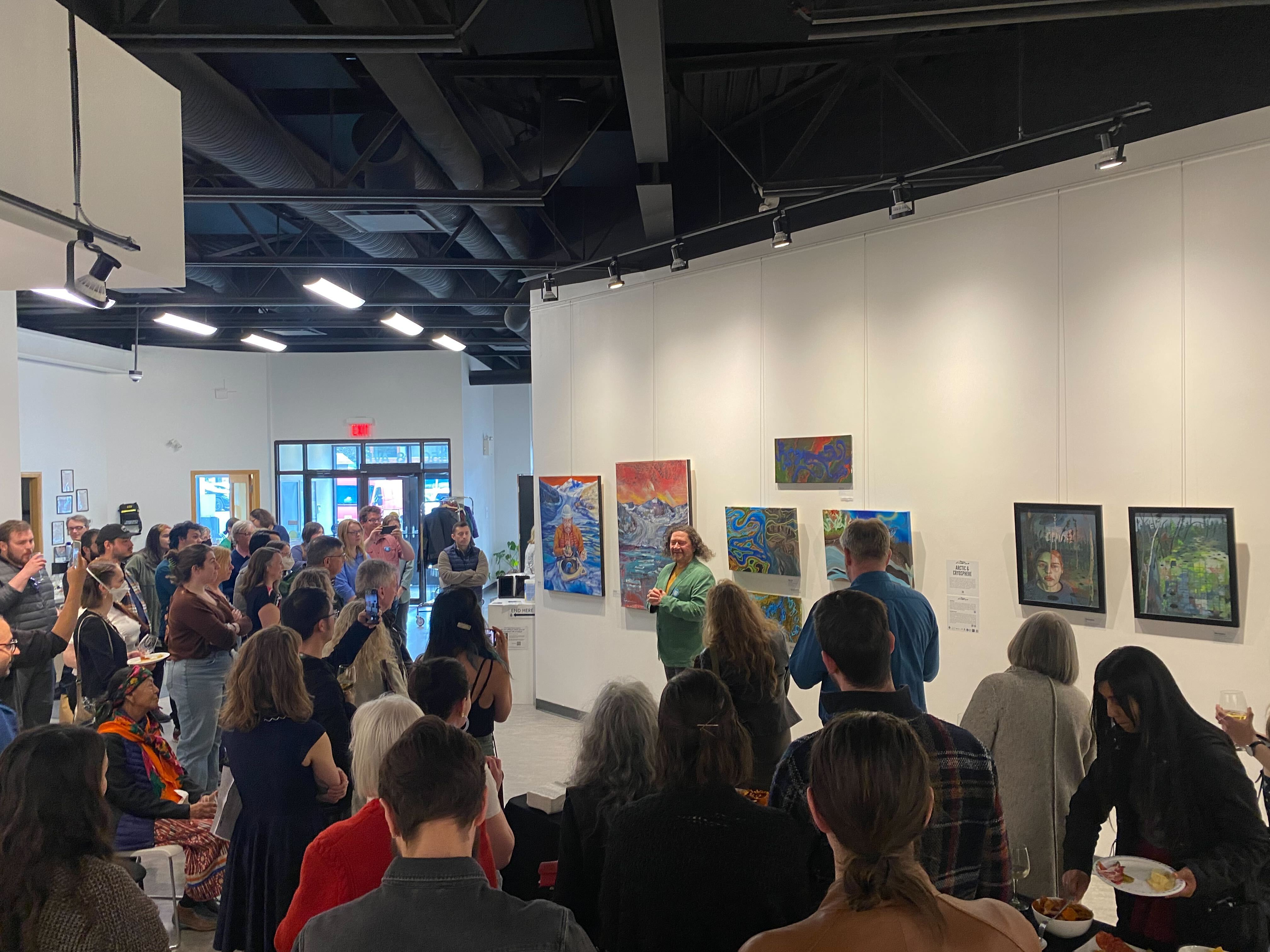
This year, the CWRA 2022 National Conference is taking place in Canmore and online between 5-8 June 2022. Our team will be attending in-person, and presenting on a variety of topics, such as: global hydrological modeling, community hydrological modeling, Canadian river national network, ensemble data assimilation in mountainous terrain, hydrological forecasting, and simulation of glacier flow. See a list of our presentations in the table below.
We also want to thank our colleagues for helping to organize the conference. Our colleague Martyn Clark serves as the co-chair of the CWRA2022 technical committee. Paul Whitfield and Guoqiang Tang lead the conference workshops that help attendees build knowledge and expertise on water related topics. Louise Arnal leads social events. Together with Janine Hay and Wouter Knoben, they are organizing an icebreaker on Sunday evening. Louise is also organizing a series of art-science events with Megan Leung (U. Calgary) to foster art-science conversations at the conference, such as an exclusive viewing of the Virtual Water Gallery exhibition at artsPlace, and a plein air activity led by Virtual Water Gallery artists. Wouter Knoben and Caroline Aubry-Wake organize tours that help attendee explore the beauty of Canmore and surroundings. Dave Casson leads sponsoring and exhibiting activities.
We are looking forward to hearing about recent scientific research and developments and to socializing with colleagues and friends from around the world. See you!
| Date | Time (MST) | Presenter | Type | Title |
|---|---|---|---|---|
| Tuesday June 7 | 10:00 - 10:20 | Kevin Shook | Oral | HGDM - a simple model for varying connected fractions of prairie basins |
| Tuesday June 7 | 11:20 - 11:40 | Wouter Knoben | Oral | Community modeling: Supporting large-domain water resources modeling through an open-source model configuration toolbox |
| Tuesday June 7 | 11:40 - 12:00 | Guoqiang Tang | Oral | Characterizing global hydrological modeling uncertainties using the Ensemble Meteorological Dataset for Planet Earth (EM-Earth) |
| Tuesday June 7 | 11:50 - 12:00 | Hongli Liu | Oral | The anatomy and uncertainty of a Canadian National River Gauging Network |
| Tuesday June 7 | 11:50 - 11:55 | Paul Whitfield | Oral | Low flow trends and drivers in snow-dominated mountain rivers of Alberta and British Columbia |
| Tuesday June 7 | 11:50 - 11:55 | David Casson | Oral | Ensemble Data Assimilation Methods for Improved Snow Estimation and Streamflow Prediction in Mountainous Terrain |
| Wednesday June 8 | 9:20 - 9:40 | Tricia Stadnyk | Oral | The isoHydRology package for Canadian hydrologists |
| Wednesday June 8 | 9:40 - 9:50 | Kevin Shook | Oral | Tgumboot - an R package for Bootstrap Analyses of Sampling Uncertainty in Goodness-of-Fit Statistics |
| Wednesday June 8 | 9:50 - 10:00 | Kevin Shook | Oral | CSHShydRology - an R package for Canadian hydrology |
| Wednesday June 8 | 10:00 - 10:10 | Paul Whitfield | Oral | Simple mapping of locations and results using R and the CSHShydRology package |
| Wednesday June 8 | 10:30 - 17:00 | Wouter Knoben | Poster | CAMELS-spat: Creating a testbed for spatially distributed hydrologic modeling |
| Wednesday June 8 | 10:30 - 17:00 | Janine Hay | Poster | Improving numerical simulations of glacier flow |
| Wednesday June 8 | 11:20 - 11:40 | Paul Whitfield | Oral | Climate Change Related Alterations to Flood Regimes Show an Increasing Rainfall Influence |
| Wednesday June 8 | 12:30 - 17:00 | Bart van Osnabrugge | Poster | Community modeling: integrating multiple models into an open-source model configuration toolbox to accelerate the uptake of science advances in hydrologic modeling and prediction |
| Wednesday June 8 | 12:30 - 17:00 | Bart van Osnabrugge | Poster | CEC-HEPEX: an open invitation to join a network of hydrological forecasting enthusiasts |
| Wednesday June 8 | 14:30 - 14:50 | Louise Arnal | Oral | A benchmark for probabilistic seasonal streamflow forecasting over North America |
| Wednesday June 8 | 14:50 - 15:00 | Chris Marsh | Oral | SnowCast: Daily forecasts of mountain snowpack using a snowdrift-permitting model |
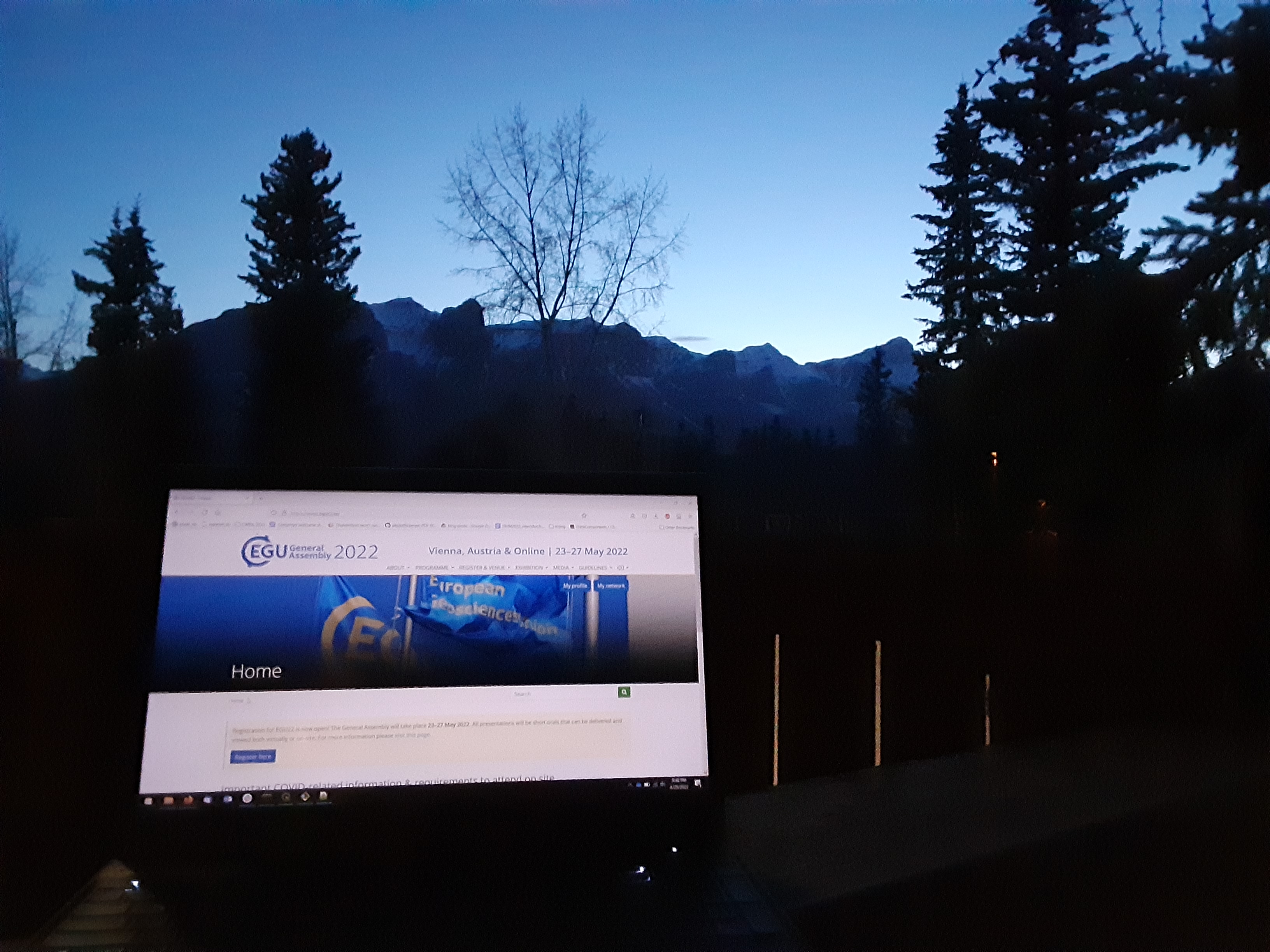
This year, the EGU General Assembly is taking place in Vienna and online between 23 - 27 May 2022. Our team will be attending remotely and in person, and presenting on a variety of topics. See a list of our presentations and those we contributed to in the table below. Note that times are local Vienna time (GMT+2).
We also reflect on the passing of Eric F. Wood, a pioneer in large-domain hydrologic modeling. Martyn Clark will deliver a presentation highlighting Eric’s scientific contributions on Monday May 23.
We are looking forward to hearing about recent scientific research and developments and to (virtually) socialise with friends and colleagues from around the world. See you next week!
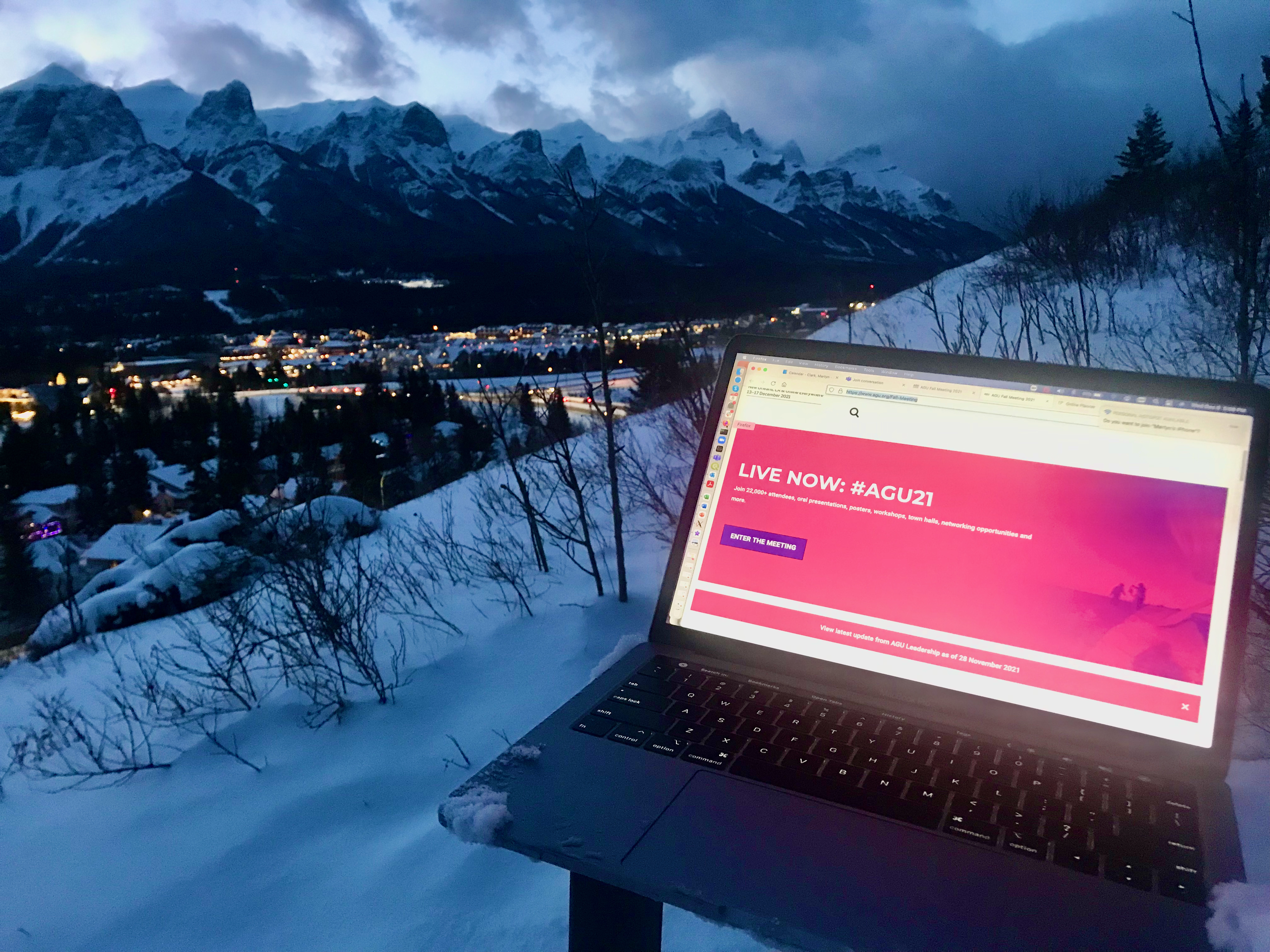
This year, the AGU Fall Meeting is taking place in New Orleans and online between 13 - 17 December 2021. Our team will be attending remotely, and presenting on a variety of topics, such as: ensemble spatial meteorological fields, community hydrologic modeling, sensitivity analysis and uncertainty quantification, performance metrics, streamflow forecasting, and plant-climate interactions. See a list of our presentations in the table below.
We also want to congratulate our colleagues for their AGU awards. Marysa Laguë won the James R. Holton Award and will be giving a talk about her latest research on Monday 13 December (more info in the table). And our colleague John Pomeroy has been named the 2021 Walter Langbein Lecturer and will give a talk on Tuesday 14 December (more info in the table).
We are looking forward to hearing about recent scientific research and developments and to virtually socialise with friends and colleagues from around the world. See you next week!
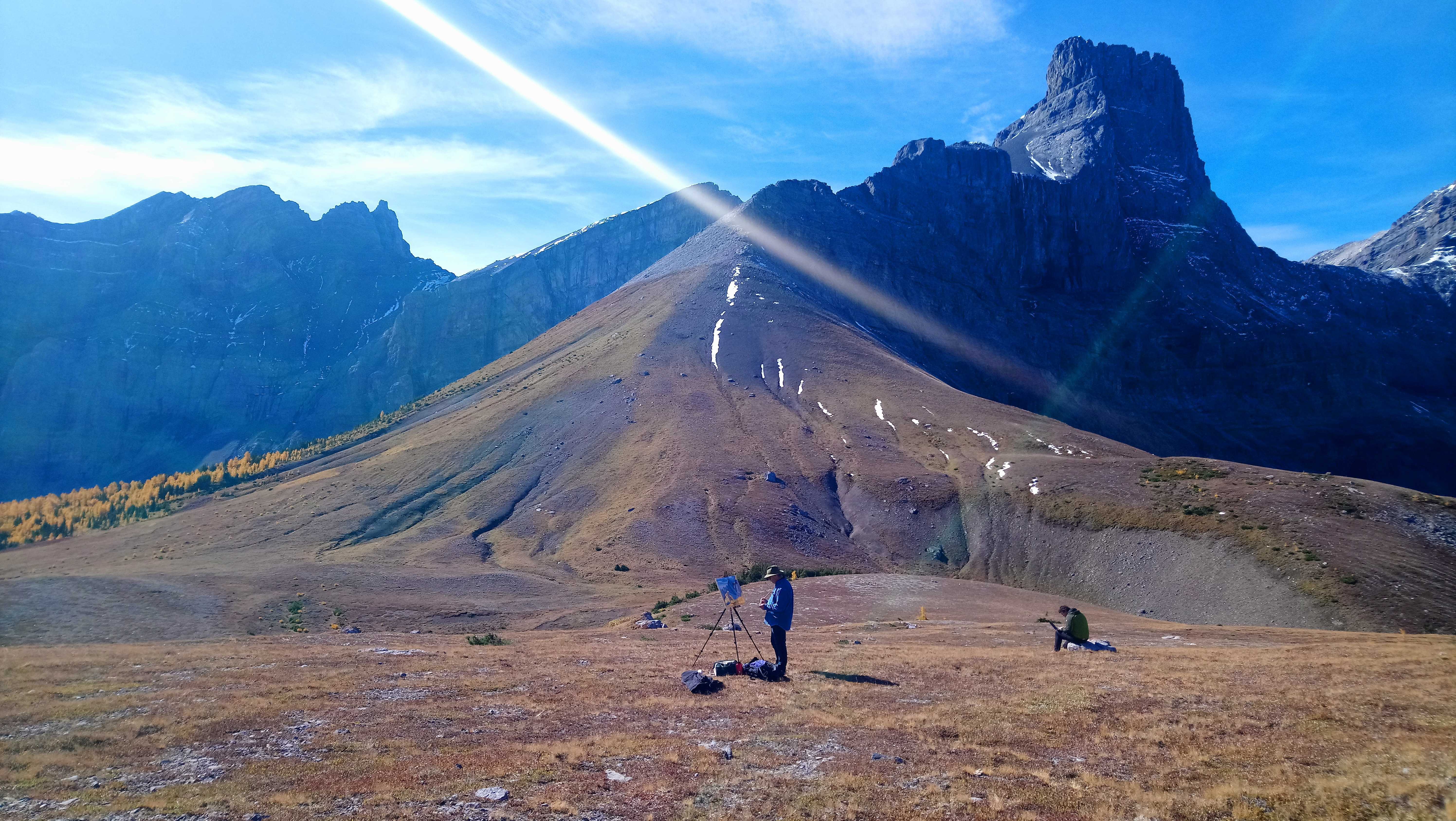
We’re writing this blog at a time when most of us thought we would be done with COVID, and most of us are still working from home. In Alberta, the ICUs in hospitals have been overflowing with some critically ill patients airlifted from one hospital to another; we’ve received emergency alerts announcing new series of restrictions; the public health crisis is relentless. In the midst of the so-called fourth wave, we’ve been asking ourselves how we coped over the past eighteen months, how we’re continuing to cope, what were some of the things that surprised us, and what the new normal will look like. In reflecting on the pandemic, we see both remarkable resilience and an opportunity for positive change.
Our challenges during COVID were certainly common. We had beginning graduate students move to town, not able to meet with colleagues and effectively build their support networks. We had new scholars ship all their belongings to Canada, only to have their flight cancelled, the border closed, and engage in a nomadic existence for several months until it was possible to enter Canada. We had visiting faculty move to town only to spend their sabbatical alone. We spent our days in a continual series of two-dimensional interactions over zoom, missing the visual cues and in-person responses that lead to excitement and innovation. We missed the hallway discussions; we missed drawing squiggly lines on the whiteboard; we missed having a cadre of scholars, all in the same environment, striving for the same ideals, feeding off each other, and helping each other succeed. We missed the in-person interactions that help us understand how our research fits into the bigger picture. We found ourselves more likely to go down rabbit holes. We found it difficult to build the personal relationships that underpin our scientific collaborations. We could no longer host scientific visitors, curtailing the exchange of ideas and the development of long-lasting collaborations. We could not travel to conferences and have those oh-so-important side-bar conversations that helped us push the boundaries of our science. We found that the (sometimes) terrible internet connectivity made it difficult to participate in video chats, to attend conferences, and to give seminars. We didn’t get to see our close friends and family for extended time periods; the extra bedrooms in our homes remained empty. Those of us with kids really struggled with juggling work and life – with daycares and schools closed, it was necessary for some of us to scale back on work in order to satisfy the development needs of our children. Many of us suffered from extreme anxiety; we kept this secret because talking about our mental health is sadly (still) not the norm.

We did learn to cope; in some cases, we learned how to thrive. Of course, Canmore Alberta is not a bad place to spend the pandemic – we’re surrounded by spectacular mountains, and even with everything closed it is possible to begin adventures from our doorstep. We were able to have walking meetings. During most of the pandemic we were able to have small outdoor gatherings. We would make the time to get together over zoom for informal coffees, even having coffee meetings every day at the start of the pandemic when working from home was new and the future was uncertain. We learned to make time for more frequent small-group science discussions, both within our team and with international colleagues. The termination of travel had some advantages: the shift to online conferences meant that some of us could now attend conferences in countries where it is difficult or impossible to obtain a visa; the termination of travel cleared more time for research and family members. Some of us thrived in the home-work environment, able to take advantage of limited distractions. Many of us found it easier to connect with existing colleagues because they were online as well. On a more personal note, the zoom meetings introduced us all to each other’s pets: Poem-Poem would always place herself directly in front of the camera, meowing gently; Nova would sit quietly and attentively, mesmerized by the scientific discourse; and Sven would bark at anything that passed the house, be it another dog, a herd of elk, or the occasional bear.
As we cope with the fourth wave, hoping that the pandemic will become less intense, and hoping that we can interact more in person, it is useful to reflect on what we see as the new normal. A few things come to mind.
We expect that universities will be defined less by their bricks and mortar and more by the communities that they serve. We’ve seen an explosion of interest in our graduate classes – the pandemic meant that we could open classes to students from all over the world (e.g., in one example, our graduate course on process-based hydrological modelling engaged 91 students from 16 different countries around the world). The initial data from the shift back to in-person learning demonstrates that classes offered online are much more popular than classes that are only offered in-person. Indeed, these experiences were evident before the pandemic where lecture halls were empty in universities that offered an online option. On the one hand, the shift to online learning means that it is possible to take advantage of the best expertise from anywhere on the planet; on the other hand, the shift to online learning also erodes the vibrancy of university campuses. This opens up a suite of new questions: To what extent will the desire to attend a given university be shaped by the pedigree of the institution, the expertise and research accomplishments of the professoriate, and the content of the curriculum? To what extent will universities be defined by their research and teaching? Given the shift to online learning and pre-built online modules (recorded lectures etc.), what is the role of professors in the learning experience? What is the willingness of students to pay for an online learning experience? To what extent will academic qualifications be offered by a single university or a consortium of universities? More generally, does the shift to online learning expand the communities that universities can serve?
We also expect that we will travel less. For many of us the termination of travel caused us to take a deep breath, sit back, and for us to ask ourselves if our travel was really necessary? Do we really need to travel to another university to serve as the external examiner on a thesis defence or to give a research seminar? Do we really need to travel to a different city to serve on a proposal review panel or to serve on an organizing committee for a conference? Do we really need to travel to meet with our colleagues in government departments? Clearly the distinction is not dichotomous and is a matter of degree. We value the opportunity to meet with colleagues, to build professional relationships, to improve our understanding of the research problems, to understand the broader context underlying individual research problems, to brainstorm, to share ideas, to co-develop new research projects, and to find solutions. Yet we understand the cost that travel has on the environment, our individual professional contributions, and our family life. We expect that we will be more strategic and judicious in accepting travel opportunities as we transition to the new normal.
We also expect that working remotely will be more common and more accepted. Does it really make sense to spend an hour or two commuting to work when we can work effectively from home? Is it necessary to commute to work every day? To what extent is it possible to work from a different city for family or lifestyle reasons? To what extent is it necessary for institutions to provide office space when their employees can work remotely? Like travel, we need to better balance the value of in-person interactions with the benefits of remote work.
Finally, we expect that we need to be much more effective in building professional relationships online. In the past few years we have witnessed the good, the bad, and the ugly of social media, and we’ve certainly seen the importance of social media during the pandemic. For example, we created a Twitter account (@CompHyd_Earth) to stay connected with other research groups and the wider community. But social media is often used for somewhat shallow unidirectional communications; an opportunity to share experiences and advertise accomplishments (e.g., “hey peeps, look at the paper I just published”). The new normal will demand that we are much more effective in building strong professional relationships online – for example, collaborating on a grant proposal with people you have never met in person; building vibrant journal clubs to discuss recent science advances; getting together with colleagues to discuss the unsolved science problems in our field. Such substance will matter and will help us define the scientific community of the future.
The pandemic has certainly provided a time for reflection and an opportunity for positive change. We’ve seen that universities have been able to effectively respond to the changes required by the pandemic, a combined effort of university administrators and the professoriate. Universities have not only risen to the occasion to meet their traditional functions; universities also are rising to the challenge to serve a myriad of communities beyond traditional university campuses. Consortiums of universities will undoubtedly be much more common in the future, building on the successes of the CUAHSI virtual university in the USA and the western Dean’s agreement in Canada. More generally, the continual evolution to remote working relationships has the potential to produce a more effective academic culture.
Since we all have a responsibility to be proactive in shaping the “new normal”, this begs the questions: Which aspects of COVID would we like to keep in the future; how can we improve the academic community? A key positive change is pivoting from an academic community that is fiercely competitive to one that is collaborative and supportive. We’ve seen some elements of this during COVID. Such evolution requires recognizing the heterogeneous contributions from the academic community in ways that look beyond traditional quantitative metrics of success (e.g., see the Declaration on Research Assessment). The evolution requires taking better care of each other’s mental health and helping each other thrive. The evolution requires that we all do our part to make the world a better place.
In closing, dear reader, please take a moment to imagine the world that you’d like to live in; imagine some specific steps that you can take to create the world that you want. Onward!

Take a moment, a few seconds, to close your eyes and visualise the Earth as seen from space. You will probably see the seas and oceans, so vast we call Earth the Blue Planet, the continents, with their beautiful shades of ocre and green, enveloped in a blanket of clouds. As a modeller, developing mathematical models of the Earth to produce forecasts of e.g. the weather and river flows, you very often have to break the Earth down into several different components: the atmosphere, the land surface and the ocean. Let’s explore together why!
I created this piece with monoprints. I first drew the contours of the Earth on a transparent plastic sheet. I then added layers of paint to this plastic sheet (as shown on the photos of the process below) before pressing a sheet of white paper on top of it to transfer the colours onto the page. After a first failed attempt (I forgot to turn around the plastic sheet before applying the paint and created a flipped version of the Earth) this repetitive process yielded four beautifully unique pieces.
The uniqueness and yet the similarity of every piece is what makes this technique very appealing to me. Even if the starting design is the same, ever so slightly different quantities and shades of the paint applied combine to create uniquely similar outputs. The amount of pressure applied when transferring the paint onto the white page can also give different textures (see for example the wave-like textures on the oceans on the bottom photo, bottom right piece). This uncertain process echoes beautifully with the idea of chaos in forecasting (read one of my previous blog posts, Chaos experiment, to find out more).
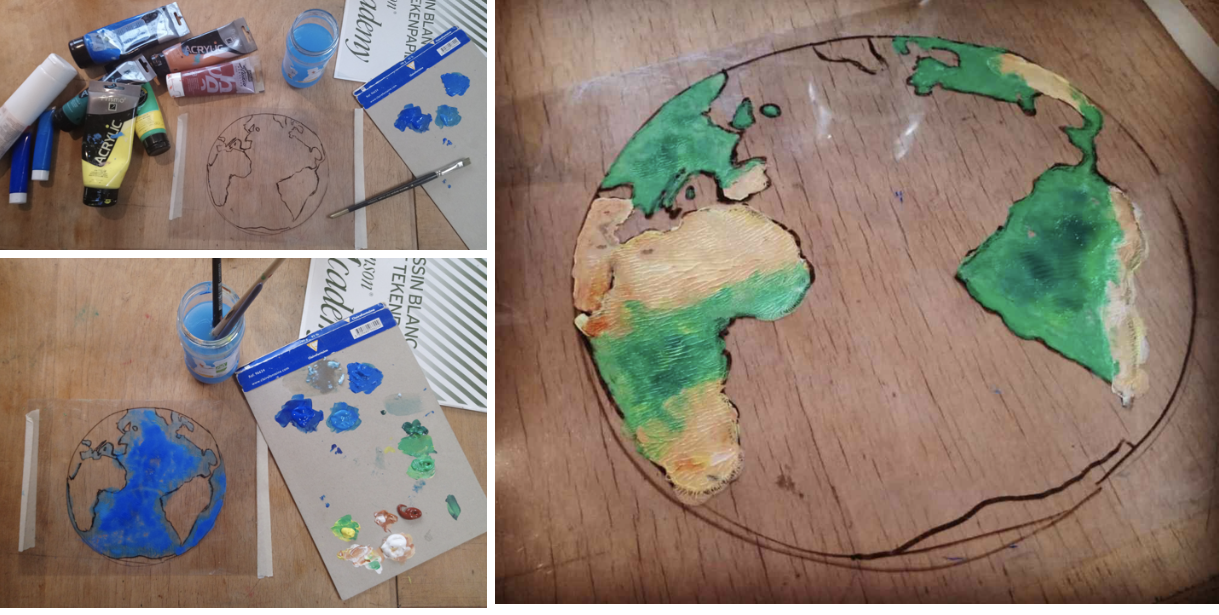
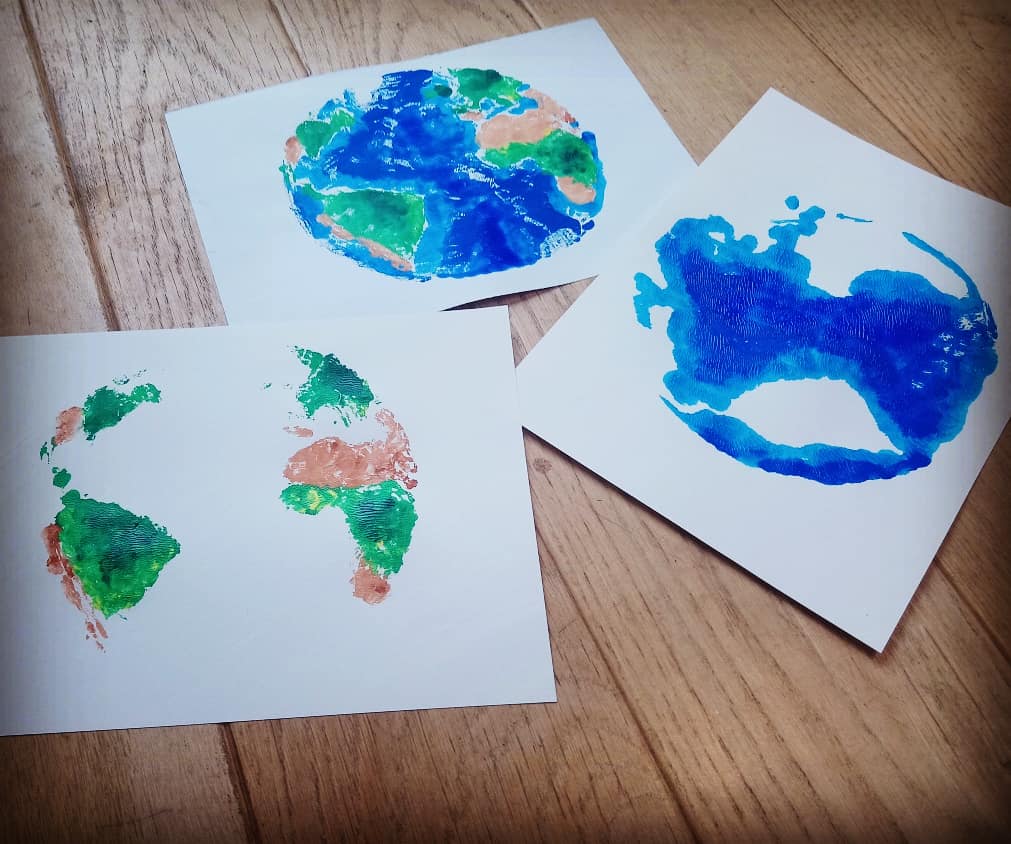
The resulting piece, a series of four prints, explores the way in which mathematical models represent the Earth to create weather and river flow forecasts. Models that represent the Earth’s atmosphere, land surface and ocean separately are called uncoupled models. With time, we have gained a better (scientific) understanding of the Earth’s physical processes (e.g. how tropical cyclones form, how the water cycle works, or how the climate is changing). We now know that it is important to combine these different models (of the atmosphere, land surface and ocean) into a single coupled model to better represent the interactions that happen at the boundaries between what we long thought were individual components. In other words, in coupled models, the atmosphere, land surface, and ocean talk to one another. But uncoupled models are not only a relic of a past understanding of our Earth system. We now have better and faster computers that allow us to run these more complex models.
So, more concretely, what are some examples of processes for which the interactions between the atmosphere-land-ocean are important?
Tropical cyclones illustrate this very well. Tropical cyclones get most of their energy from the heat transported from the ocean into the atmosphere. They need ocean temperatures of at least 27°C (compared to a global average of ~16°C) to a depth of ~50m. If the depth of warm water is too shallow, the amount of energy released into the atmosphere may decrease and the tropical cyclone may weaken quite quickly (read Rebecca Emerton’s blog post Natural Hazards: Hurricanes, Typhoons & Cyclones to find out more about tropical cyclones or the ECMWF blog post How to couple the ocean, sea ice and the atmosphere in forecasts by Kristian Mogensen to find out more about coupled forecasting). Artist and philosopher Renate Quehenberger recently collaborated with Kristian Mogensen, myself, and scientists from the the European Commission’s JRC to create the SciArt project GAIA 5.0. Its centrepiece is a 3D virtual reality installation showing the development of 2 tropical cyclones in 2018, based on ECMWF data.
The water cycle is another very good example of these interactive processes. The entire water cycle is based on a series of interactions between the atmosphere-land-ocean. For example, how much water evaporates from the oceans will influence how much rain will fall on the land and how much water will flow through the nearby rivers (too much? too little?). Working with uncoupled models you may lose valuable information about these interactions, which in turn might impact the quality of your weather and river flow forecasts. For my work on forecasting river flow on seasonal timescales (for the next several months), making sure the atmosphere, land surface and ocean “talk to one another” is very important as a lot of the slow influential factors live at the boundaries between these components. A good example of such factors is the El Niño events, a warming of the surface waters in the Pacific Ocean which can cause floods or droughts months after and kms away! (find out more in Rebecca Emerton’s post What is El Niño? (And can it really impact coffee & chocolate prices?) and in this NASA Earth Observatory post). You’re probably asking yourself: what about processes on even longer timescales, like climate change? You’re exactly right!
Climate models describe atmosphere-land-ocean physical processes to help us understand how the climate is changing. But biological and chemical processes also have an impact on the Earth’s climate. For example: plants and industries change levels of CO2 (and other greenhouse gases) in the atmosphere, ocean currents determine the nutrients available to phytoplankton, and temperature and rainfall shape life on land (droughts affect plant cover, which may in turn dampen or exacerbate the drought). Models that represent a broad range of interactions are called Earth system models (ESM; read this Nature Education article to find out more).
Randall et al.’s 2018 article, 100 Years of Earth System Model Development, provides a great overview of the birth and evolution of ESM.
I created this piece for The first ECMWF science and art exhibition, which I co-curated earlier this year. At this exhibition, over 80 artworks from 27 artists and scientists were displayed in the ECMWF Weather Room from 18-21 February 2020. The displayed sculptures, paintings and photography all conveying weather-related topics in their own beautifully unique ways. Have a look at the blog post (link above) to see the exhibition highlight video.
Whilst we have made immense progress in coupled modelling over the last decades, it goes without saying that there are still many scientific and technological challenges to tackle. What will be the future of coupled modelling? Digital twins of the Earth ingesting a vast array of Earth observations? As Randall et al. (2018) state in their article: “A comprehensive ESM can simulate many of the emergent phenomena that we see in nature, but the output of such a simulation is just a pile of numbers; it is not an explanation of the natural world. To claim that we understand […] the real world, we must work to create much simpler models that can […] reproduce the key results of the comprehensive models”.
Ultimately, I believe that the solution to making progress in representing our beautifully interconnected Earth is working with an interconnected and diverse group of (computer) scientists, computer engineers, artists, philosophers, and many more. Fostering dialogues across a wider audience has the power to lead to new out-of-the box ideas to tackle current environmental issues.
This blog post was also published on my SciArt blog.
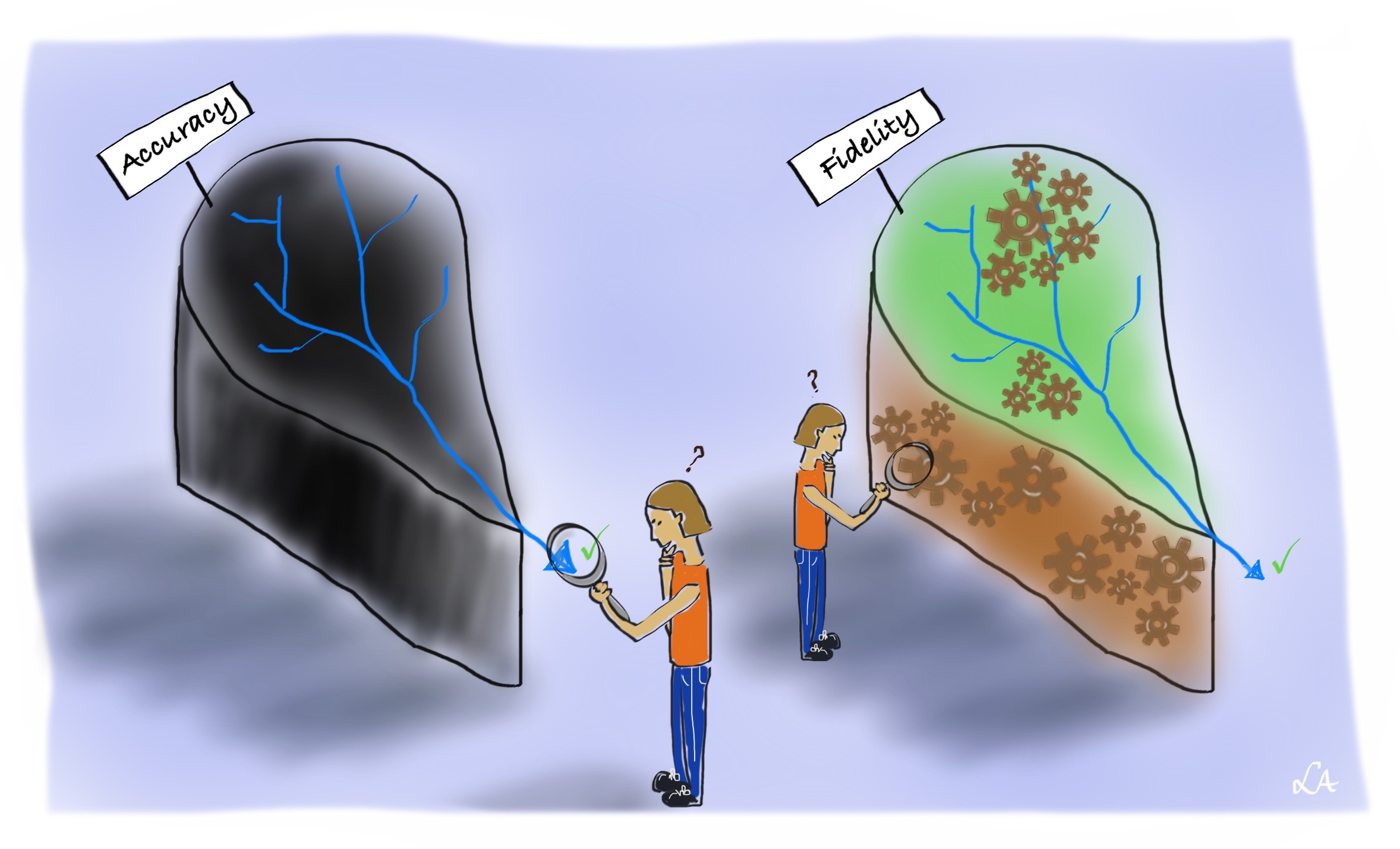
I like adjectives. In fact, one of the reasons I enjoy writing letters of support for my colleagues is because it gives me the opportunity to make extensive use of adjectives. I get to use words like spectacular, inquisitive, unselfish, and revolutionary. I become satisfied when my flowery language paints a portrait of my colleagues that helps them get the recognition that they deserve. It’s all about the adjectives (and my colleagues of course!).
I have encountered a situation, however, where the English language suffers from a shortage of adjectives. In hydrological modelling we often make the distinction between accuracy and fidelity. Accuracy is used to describe discrepancies between model simulations and observations; fidelity is used to describe the extent to which a model faithfully represents the dominant processes in the region where it is applied. Accuracy is a necessary (yet not sufficient) condition for fidelity.
You may now notice my conundrum: whilst the adverb faithfully can be adequately paired with fidelity, the adjectives to describe model fidelity are, arguably, inadequate. We can use the term accurate to describe model accuracy, but it is awkward to use the term faithful to describe model fidelity. The awkwardness arises because faithful has religious connotations, as faith may not be supported by facts.
An alternative can be found in Olde English. As it turns out, there is another adjective for fidelity: the (now obsolete) adjective fidelious (or fidelitous). The term fidelious may, for some, invoke memories of Harry Potter (e.g., the Fidelus charm), and this simply underscores its panache. The adjective fidelious, I think, has tremendous utility in the hydrological sciences.
I respectfully suggest, dear reader, that we introduce the age-old adjective fidelious into the hydrological vernacular. Our manuscripts will be all the better for it.

Prologue. Process-based hydrological models can be roughly divided into two (ill-named and overlapping) categories (e.g., see Hrachowitz and Clark, 2017):
We started our career using bucket-style models, and we have recently moved to the large-domain physically-based land modeling community. Our current research topics in a nutshell can be summarized as: (1) To understand the weakness in large-domain hydrological models and for model improvement and (2) to represent and assess the often-neglected water management component in models of the terrestrial water cycle. Here we provide a brief reflection of our observation through our journey along the continuum of model complexity.
Workflow, the biggest difference. The greatest differences between these two main branches of hydrological modeling is not only the underlying representations of the physics, but also the underlying workflow! “A workflow consists of an orchestrated and repeatable pattern of activity, enabled by the systematic organization of resources into processes that transform materials, provide services, or process information” (from Wikipedia).
In typical applications, bucket-style modellers tend to spend less time on the pre-processing of model inputs than on modelling itself. Input data tends to be catchment-averaged and these models rarely require more data than precipitation, temperature and some estimate of potential evapotranspiration. Because these models tend be used in a spatially aggregated fashion and rely on effective parameters, less work is required to define the structure of the model domain (topography, vegetation, soils, geology) and the models have lower computational costs). The simplicity of these models means that much more effort can be spent on topics such as parameter estimation, sensitivity analysis, and uncertainty analysis.
The situation is quite the opposite in the large domain physically-based land modeling community, where more of the modeling effort is focused on the model workflow. These models are typically spatially distributed over a large geographical domain, and tend to require large amounts of input data: forcing variables for mass and energy balance calculations, estimates of soil type and land use, accurate delineations of catchments and routing networks, etc. Given the computational time associated with these kinds of models, sensitivity and uncertainty analysis tend to receive relatively less attention.
Despite these differences, both modelling approaches share practical challenges such as data collection, quality control, basic pre-processing of forcing, reducing computational costs, etc. Different models hence have similar tasks in the model workflow. We can thus ask ourselves questions such as: how many times have we delineated a catchment for a given outlet point, and what are the best GIS tools to do so? How many times did we sort hydrograph data, fill the missing values, remove outliers? How often did other people download the same data and work through the same tasks that we did? Did we develop a tool that does the job automatically? Is our code for model workflow of sufficient quality to be shared with our colleagues? The answer to these questions may bring us closer to elements of a universal workflow (Yes! Before we can talk about universal models or community models, we need a universal workflow).
Model reproducibility is enabled by a smooth workflow. We are currently part of a wider effort to streamline and share workflows for land models. We can improve the reproducibility of our results by explicitly documenting every step of the model workflow, from data download to model evaluation. It also considerably reduces the start-up time needed by new group members which in turn helps us to focus, and spend more time on science questions. More than its practical benefits, a well-designed workflow increases the transparency of our science and the robustness of our scientific findings. We believe that an excellent idea will die if it lacks a proper workflow.
Designing a workflow is a collaborative endeavor. The lack of collaborative workflow management can result in unbalanced workload between team members. This usually translates into an unproductive workload for Ph.D. students or post-doctoral researchers because they spend time on manual analysis or developing procedures that could be better automated or systemized. Model workflow requires many skills, such as the ability to use high-performance computers, learning Linux commands, learning C or Fortran (Python and R help but may not be sufficient), and collaborative code development (e.g. GitHub). Users/developers should not get trapped in their own workflow. A good workflow is a dynamic and agile one that can adapt to the need of modelers and users while it respects the level of education and intellectual ability of every single person and leaves enough room for a modeler to make reasonable changes and amendments to explore the underlying science questions.
Learning from each other, an avenue to explore. There is a certain lack of knowledge transfer between the two modelling communities we are part of (despite the recent efforts to understand and bridge this gap, e.g., Archfield et al., 2015; Clark et al., 2017). The lack of knowledge transfer is understandable given the different foci of the modeling communities, the target audience, and also the context of the modeling efforts. However, there is a lot to be learned from each other. As an example, there is a significant body of literature on the effect of model structure in conceptual models, or similarly, hillslope hydrology at the hillslope scale that can be incorporated into large scale modeling (e.g., see Gharari et al., 2019 and Gharari et al., 2020, and the many more open questions in this area). It is also good for bucket-style modelers to learn from the large-domain physically-based modeling community, for example by incorporating basic energy balance calculations into bucket-style models. Having worked on both topics, we notice how each modelling approach brings new perspectives into our modeling efforts.
We are still learning, constantly learning. As part of the Computational Hydrology group at the University of Saskatchewan, we are busy setting up land models for the entire North American domain and improving continental-scale routing schemes. We are having fun! Every day, we learn more about python and its packages’ capabilities, Fortran, available local and global datasets that can be used in our modeling efforts. We do a lot of “GitHub-ing” these days. Re-using each other’s code, reviewing each other’s scripts and sharing them with the wider public. There is still work to be done for our efforts to bear fruits, but we are hopeful that we will make important contributions to the science and practice of large-domain hydrological modelling.
Looking back on what we’ve learned so far, we would probably have done many things in our previous work differently. We believe that is how the learning curve should be, and are working hard to set up our workflows to be able to deal with such evolving insight!
Final words. Moving from one branch of modelling to another has not been an easy process, but we think it helped us quickly grow beyond the skills we learned during our PhDs. This blog post is aimed to create discussion and thinking about the infrastructure needed to make switching between different types of models and modelling approaches possible. We have for the moment settled on well-documented workflows to enable this. Feel free to share this post with your interested colleagues and do not hesitate to contact us (the authors of the blog). We would be more than happy to keep the conversation moving. Onward!

As we enter our third month of social distancing, it is nice to remember the wonderful international visitors to the lab over the past year. The Coldwater Lab is normally a buzzing hub of activity. Being close to a major international airport (Calgary), we have plenty of interaction between those who work at the lab and those fortunate enough to visit us for a while. In these times of social distancing and limited travel, we look back on the illustrious visitors to the lab in the past 9 months or so.
Berit Arheimer, who is currently head of the Unit for Hydrological Research at SMHI (Sweden) and president-elect of the IAHS, visited the lab in July 2019 to explore potential collaborations.
Autumn 2019 saw a string of visitors in quick succession. Bart Nijssen (Univeristy of Washington, USA), Adrian Harpold (University of Nevada, USA) and David Hannah (University of Birmingham, UK) all visited Canada as part of the University of Saskatchewan Global Institute for Water Security Distinguished Lecture Series and found time to visit Canmore for a few days as well.
We got to welcome three early career researchers for longer stays, two of which during autumn. Keirnan Fowler (University of Melbourne, Australia) visited for two weeks to initiate collaboration on model benchmarking. PhD candidate Lina Stein (University of Bristol, UK) joined us for a three-month research visit to investigate flood generating processes in North America. Lina’s supervisor Ross Woods (University of Bristol, UK) visited us for a week during Lina’s research visit.
January 2020 saw few visitors, presumably because Alberta had the honor of being one of the coldest places on the planet for a while. Things picked back up in February when Manuela Brunner (National Center for Atmospheric Research, US) joined us for a three week visit to share thoughts on dominant flood generating processes and the capabilities of current hydrologic models to represent these. Around the same time, Dmitri Kavetski (University of Adelaide, Australia) included Canmore as one of the stops on his research tour.
In early February, Canmore was also the home of a Global Water Futures: Core Modelling Geospatial Intelligence meeting that brought together two dozen research personnel to discuss ways to improve model workflows and code sharing, large-domain parameter estimation and model benchmarking efforts across GWF. Luis Samaneigo (University of Leipzig, Germany) was the plenary speaker at this meeting, where he shared his insights on multiscale parameter regionalization.
We saw our last visitors in early March, when Andy Wood and Naoki Mizukami (NCAR, US) visited us for several days of intense discussions. This visit advances Martyn’s work with Naoki in developing version 2 of the mizuRoute routing model, expanding the team to include our team member Shervan Gharari to incorporate lakes and reservoirs in mizuRoute.
We’re all looking forward to transitioning to the “new normal” and future interactions with the international science community, in whatever form these interactions may take! Stay safe everyone!
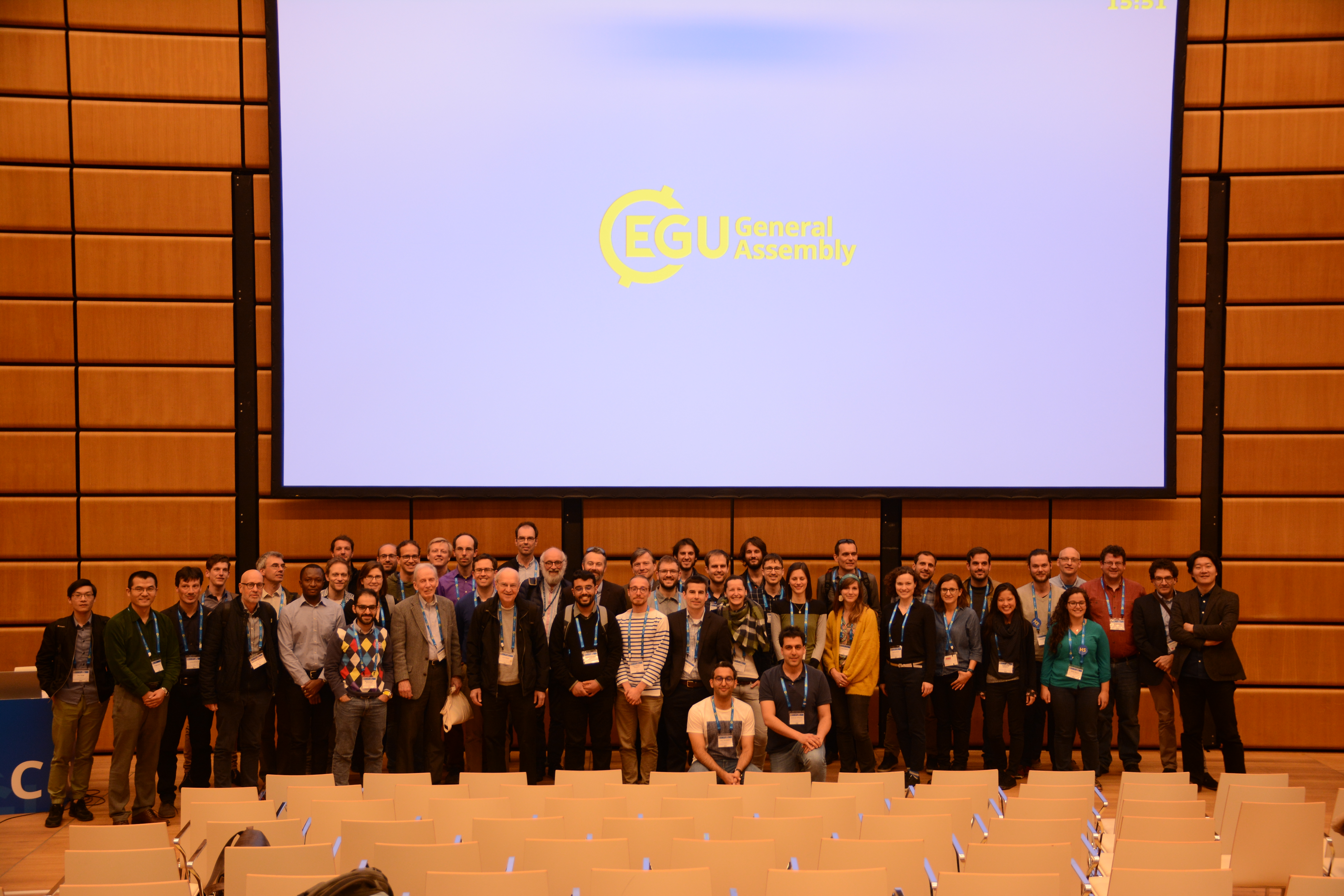
Last year we had a wonderful session at the EGU 2019. As lead convener, I was working closely with my colleagues Björn, Luis, Simon and Sina to organize more than 50 abstracts and 3 oral blocks. We had thought-provoking contributions from catchment to global hydrology. From remote sensing to field observation. A wide range of expertise and opinion.
This year however, things are a bit different. We are depending on a text-based system to present and convene. I was thinking to myself; “who will participate?!”. But it turns out that there are many more enthusiastic scientists that I initially anticipated.
This year, we move on to convene our session while sitting in totally different time zones. For the good memories, I keep looking at this picture from EGU 2019. Hope everyone in this picture is safe and happy. And I sincerely hope to make another photo like this next year.
From our side, the computational hydrology team has the following contributions at EGU 2020:
HS2.2.1
Models and Data: Understanding and representing spatio-temporal dynamics of hydrological processes
Convener: Björn Guse | Co-conveners: Shervan Gharari, Sina Khatami, Luis Samaniego, Simon Stisen
Mon, 04 May, 08:30–12:30, Chat Mon, 04 May, 14:00–15:45
HS2.5.2
Large-sample hydrology: characterising and understanding hydrological diversity
Convener: Sandra Pool | Co-conveners: Gemma Coxon, Wouter Knoben, Nicolas Vasquez, Keirnan Fowler
Fri, 08 May, 08:30–10:15
HS4.6
From sub-seasonal forecasting to climate projections: predicting hydrologic extremes and improving water management
Co-organized by CL4
Convener: Christopher White | Co-conveners: Louise Arnal, Tim aus der Beek, Louise Crochemore, Andrew Schepen
Thu, 07 May, 10:45–12:30
EGU2020-1850 | HS2.4.1 | Highlight
Spatial dependence of floods and droughts: learning from differences in regional and seasonal patterns
Manuela Irene Brunner, Eric Gilleland, Daniel Swain, Andy Wood, and Martyn Clark
Thu, 07 May, 08:30–10:15 | D61
EGU2020-3018 | HS2.2.1
Evidence-based conceptual requirements of regional groundwater processes for hydrological simulations
Louisa Oldham, Jim Freer, Gemma Coxon, Nicholas Howden, John Bloomfield, and Christopher Jackson
Mon, 04 May, 10:45–12:30 | D189
EGU2020-4184 | HS2.2.1
Process-based model evaluation of cold region hydrological processes
Wouter Knoben, Abbas Fayad, Vincent Vionnet, and Martyn Clark
Mon, 04 May, 08:30–10:15 | D172
EGU2020-6524 | HS2.5.1
On the exploration of alternative spatial representation for land models; a vector-based setup for the Variable Infiltration Capacity model
Shervan Gharari and Martyn Clark
Thu, 07 May, 14:00–15:45 | D163
EGU2020-7349 | EOS7.10/HS1.2.8
The emergence of community models in hydrology
Nans Addor, Martyn P. Clark, and Brian Henn
Mon, 04 May, 16:15–18:00 | D3918
EGU2020-9619 | NH1.5
Monitoring the efficacy of Natural Flood Management structures on flow attenuation and flood risk reduction
Tamsin Lockwood, Jim Freer, Katerina Michaelides, Gemma Coxon, Tom Richardson, Richard Brazier, Ben Thorne, and Louise Webb
Mon, 04 May, 14:00–15:45 | D1911
EGU2020-9918| HS7.10/NH1.12
Understanding catchment influences on flood generating processes - accounting for correlated attributes
Lina Stein, Martyn Clark, Francesca Pianosi, Wouter Knoben, and Ross Woods
Tue, 05 May, 16:15–18:00 | D337
EGU2020-11943 | HS7.10/NH1.12
A Global Assessment of Non-Stationarity in Extreme Precipitation
Razi Sheikholeslami, Simon Michael Papalexiou, and Martyn Clark
Tue, 05 May, 16:15–18:00 | D340
EGU2020-10219 | HS2.5.1
Comparing the impact for hydrology of the new ERA5 reanalyses dataset over ERA-Interim for 8 hydrological models in 6 catchments using the eWaterCycle community modelling environment.
Rolf Hut, Niels Drost, Jerom Aerts, Laurene Bouaziz, Willem van Verseveld, Bert Jagers, Fedor Baart, Edwin Sutanudjaja, Lieke Melsen, Andrew Bennett, Louise Arnal, Fabrizio Fenicia, Leonard Santos, Emiliano Gelati, Marco Dal Molin, Wouter Knoben, Shervan Gharari, Caitlyn Hall, Eric Hutton, and Nick van de Giesen and the the eWaterCycle comparison team from the Netherlands eSciencecenter.
Thu, 07 May, 14:00–15:45 | D159
EGU2020-20187 | HS4.4
Does the application of multiple hydrological models improve seasonal streamflow forecasting skill?
Bastian Klein, Ilias Pechlivanidis, Louise Arnal, Louise Crochemore, Dennis Meissner, and Barbara Frielingsdorf
Fri, 08 May, 10:45–12:30 | D208
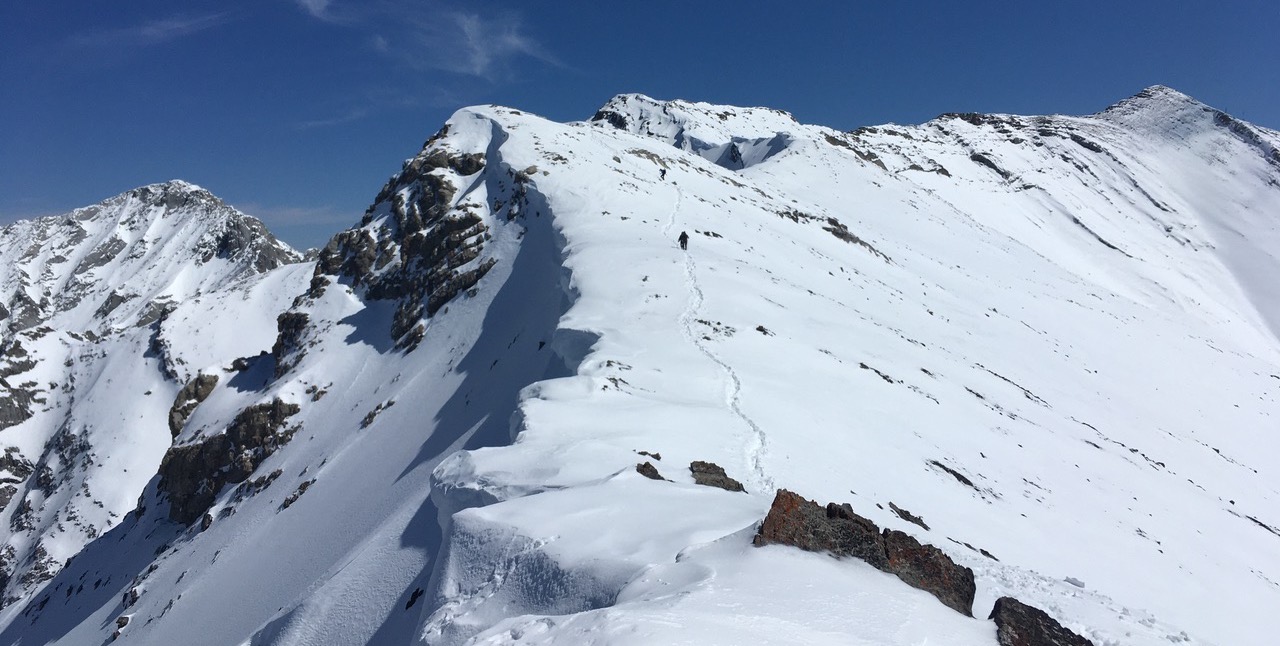
The computational hydrology group is now pretty much in full swing. Most of the team is assembled and engaged in continental-domain hydrological modelling and forecasting, with a focus on advancing prediction capabilities over North America.
Martyn Clark is active in several areas of computational hydrology. His research focuses on large-domain hydrological modelling.
Guoqiang Tang is developing a probabilistic spatial meteorological dataset for North America in order to characterize uncertainties in spatially distributed hydrological model forcings. His research extends previous work by Clark and Slater (2006) and Newman et al. (2015) to condition station-based estimates on reanalysis and satellite data.
Wouter Knoben is developing a comprehensive model-agnostic benchmarking system for North America in order to understand model weaknesses and identify priorities for future model development. Wouter’s current work is configuring the SUMMA model (Clark et al., 2015) for the North American domain in order to provide initial capabilities for continental-domain modelling and to evaluate alternative modelling approaches.
Christian Hart is a research assistant focused on developing model test cases for operational monitoring networks. Christian’s initial work is to configure and evaluate SUMMA for the SnoTEL network.
Shervan Gharari is focused on incorporating lakes and reservoirs in our continental-domain network-based routing model mizuRoute (Mizukami et al., 2016). Shervan’s work is part of a larger collaboration with NCAR to improve river routing in Earth System models and bring in often neglected human dimension in modelling of hydrological cycle.
Louise Arnal has recently joined us after completing a PhD at the University of Reading and ECMWF. Louise is focused on ensemble streamflow prediction, starting with advancing understanding of the sources of predictability in subseasonal-to-seasonal streamflow forecasts across North America. Louise is also advancing science engagement through the fusion of science and art.
Reza Zolfaghari also recently joined us, having recently completed his PhD at McMaster University. Reza is working on improving the numerical implementation of the SUMMA model (Clark et al., 2015), advancing both efficiency and accuracy/robustness through the use of alternative numerical solvers. Reza has a joint appointment with Ray Spiteri in the Computer Science Department at the University of Saskatchewan.
Jim Freer is a Visiting Professor from the University of Bristol, having just started his two-year stint at the Coldwater Lab. Jim is engaged in most of our research thrusts in computational hydrology, with his personal research focused on quantifying uncertainty in streamflow data.
All of our work is made possible by the efforts of Joy Mitsogianni. Joy provides us all with excellent support to keep things running smoothly.
While the team is mostly in place, we do have a couple of openings for students and postdoctoral scholars. Please contact Martyn Clark if you are interested in joining our team!

USask/Canmore Computational Hydrology at CWRA 2022: things not to miss!
Posted on 05 Jun 2022
USask/Canmore Computational Hydrology at EGU 2022: things not to miss!
Posted on 15 May 2022
USask/Canmore Computational Hydrology at AGU 2021: things not to miss!
Posted on 10 Dec 2021 Posted on 01 Oct 2021
Posted on 01 Oct 2021